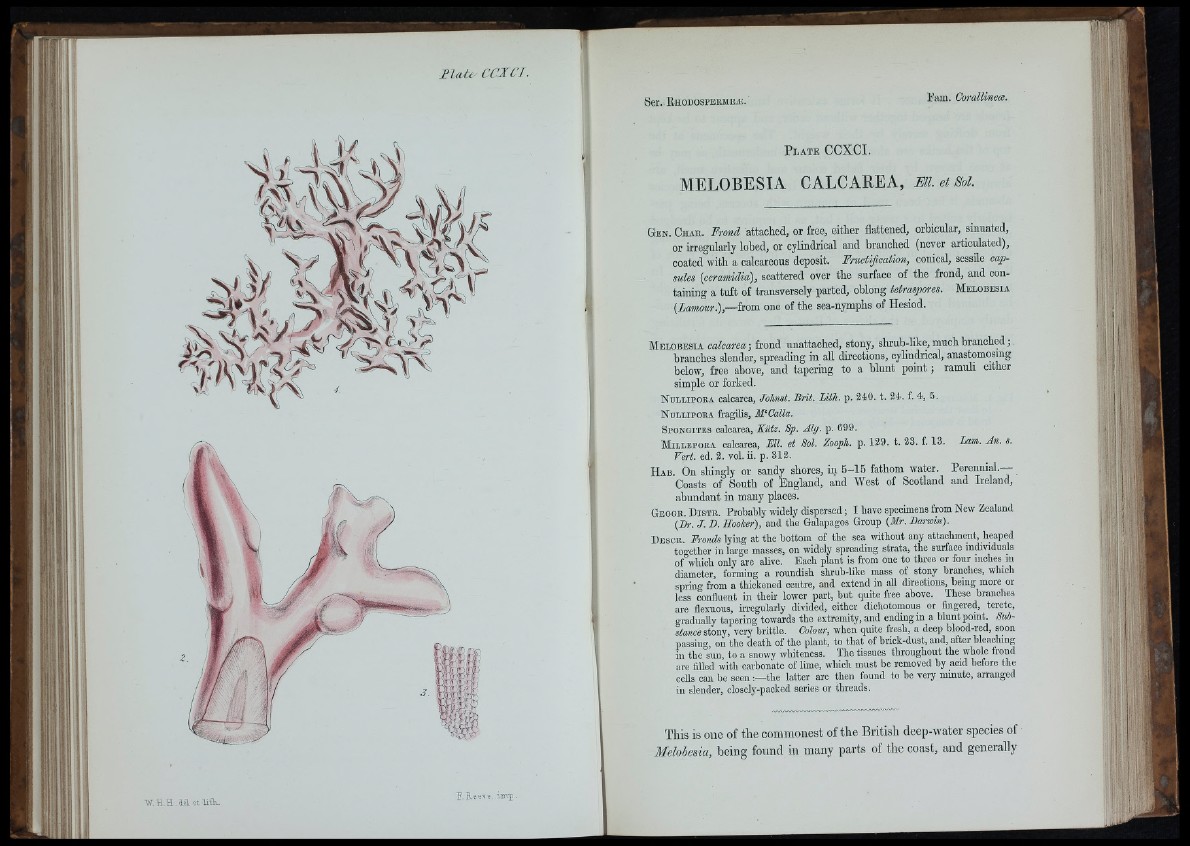
Itale CrXCI.
Ser. E h o b o s p e r m e æ .
P l a t e CCXCI.
MELOBESIA CALCAREA, Ml. et Sol.
l.T - e e v e .im j e .
G e n . Ch a r . Frond attaohed, or free, either flattened, orbicular, sinuated,
or irregularly lobed, or cylindrical and branched (never articulated),
coated with a calcareous deposit. Fructification, conical, sessile capsules
{ceramidia), scattered over the surface of the frond, and containing
a tuft of transversely parted, oblong tetraspores. M b l o b b s i a
{Lamour.),— ixom one of the sea-nymphs of Hesiod.
M e l o b e s ia calcarea ; frond nnattaclied, stony, shrub-like, much branched ;
branches slender, spreading in all directions, cyhndrical, anastomosing
below, free above, and tapering to a blunt point ; ramuli either
simple or forked.
Lam. An. s.
N ullipora calcarea, Jolimt. Brit. lÀtk. p. 240. t. 24. f. 4, 5.
N u l l i p o r a fragilis, M'Calla.
S pongites calcarea, Kütz. Sp. Alg. p. 699.
M ill epo ra calcarea. Bit. et Sol. Zooph. p. 129. t. 23. f. 13.
Vert. ed. 2. vol. ii. p. 312.
H ab. On shingly or sandy shores, in 5-15 fathom water. Perennial.—
Coasts of South of England, and West of Scotland and Ireland,
abundant in many places.
G e o g r . D i s t r . Probably widely dispersed ; I have specimens from New Zealand
{Dr. J. B . Hooker), and the Galapagos Group (Mr. Barwiu).
D e s c r . Fronds lying at the bottom of the sea without any attachment, heaped
too-ether in large masses, on widely spreading strata, the surface individuals
of°which only are alive. Each plant is from one to three or four inches in
diameter, forming a roundish shrub-like mass of stony branches, which
spring from a thickened centre, and extend in aU directions, being more or
less confluent in then lower part, but quite free above. These branches
are flexuous, irregularly divided, either dichotomous or fingered, terete,
gradually tapering towards the extremity, and ending in a blunt point. Substance
stony, very brittle. Colour, when quite fresh, a deep blood-red, soon
passing, on the death of the plant, to that of brick-dust, and, after bleaching
in the sun, to a snowy whiteness. The tissues throughout the whole frond
are filled with carbonate of lime, wliich must be removed by acid before the
cehs can be seen the latter are then found to be very minute, arranged
in slender, closely-packed series or threads.
This is one of the commonest of the British deep-water species of
Melobesia, being found in many parts of the coast, and generally
■li'i
ill